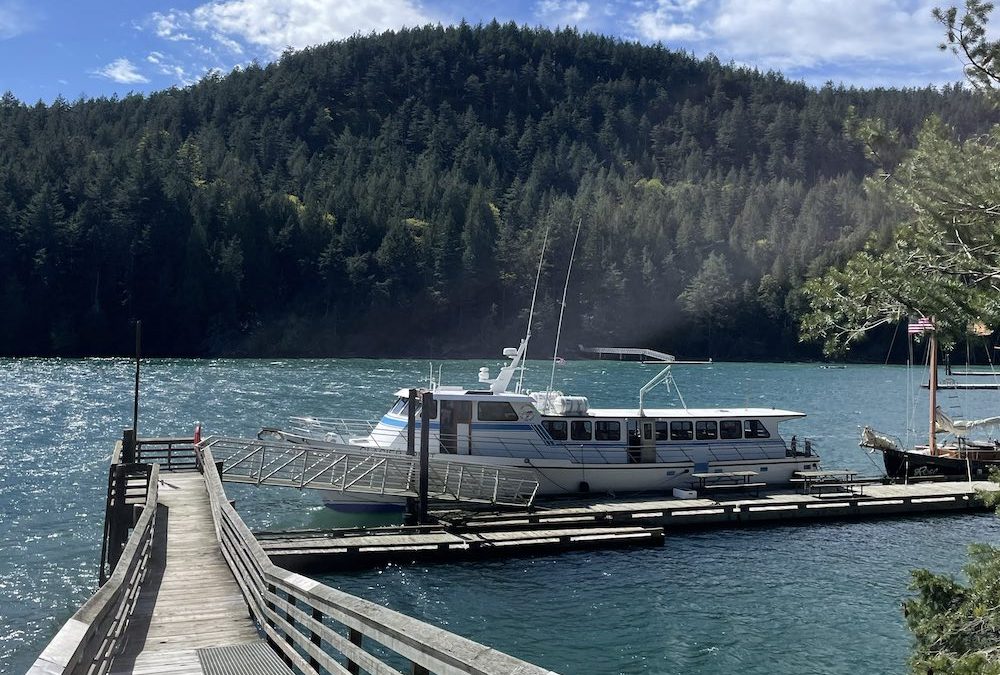We are often asked: “What’s it like on one of your 3-day cruises?” Great question! Our Director of Crew Operations and Safety Colleen Farrell served as naturalist onboard our April 7-9, 2025 3-Day Olympic Birdfest Birdwatching & Wildlife Cruise. Colleen is one of our most knowledgeable birders, and in 2024 was the first birder to spot a rare juvenile red footed booby in our waters. She took the time to assemble a daily write-up of each day of her trip. Enjoy (and thanks, Colleen!).
Day 1 – Swinomish Slough to Roche Harbor
The spring 3-day trip always puts a focus on our largest group of visitors to the Salish Sea: and even though we take care of our lovely passengers from around the world, I of course am talking about the migratory birds to the region.
We started the day with a trip up the west side of Whidbey Island. Wind and waves made bird spotting challenging but we managed to find pelagic cormorants, several scoters and rhinoceros auklets. As I was speaking to a couple from California about the potential to see whales in the area, I had a “THAR SHE BLOWS” moment with a gray whale out the window off the port quarter! We got a few nice looks before that gray whale, much like us, needed to escape the breeze and we moved on to Deception Pass.
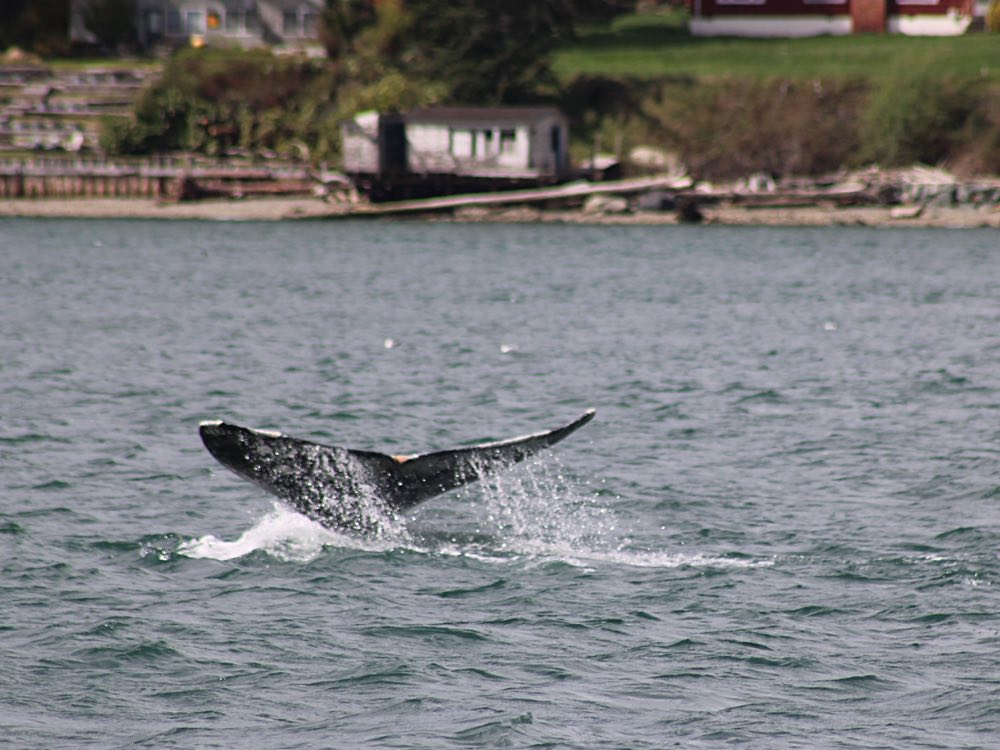
Immediately turning by Deception Island we were greeted by two VERY friendly common loons. I was bewitched by their checkered pattern and close pass! The last loons I saw about a week ago were still in their more informal winter plumage but almost every bird we saw was dressed to impress in their full breeding regalia. We also saw about 20 of my favorite bird, the pigeon guillemot. Their adorable red feet and high pitched “squeaks” were a special thing to share with our guests.
After enjoying a slow journey under Deception Pass Bridge, we embarked on a sojourn around Strawberry Island where we got a gander at a gaggle of Canada geese snoozing in the grass and a couple of harbor seals acting as inconspicuous as the barnacle encrusted shoreline. No more than two minutes after picking up speed, Captain EJ caught a glimpse of another gray whale! This time, it only took a few moments to identify one of our favorites, CRC53 “Little Patch.” Little Patch has been visiting the Puget Sound area for over 30 years and it was a special moment to share his presence with our passengers who expected birds but were pleasantly surprised by the impromptu whale watch.
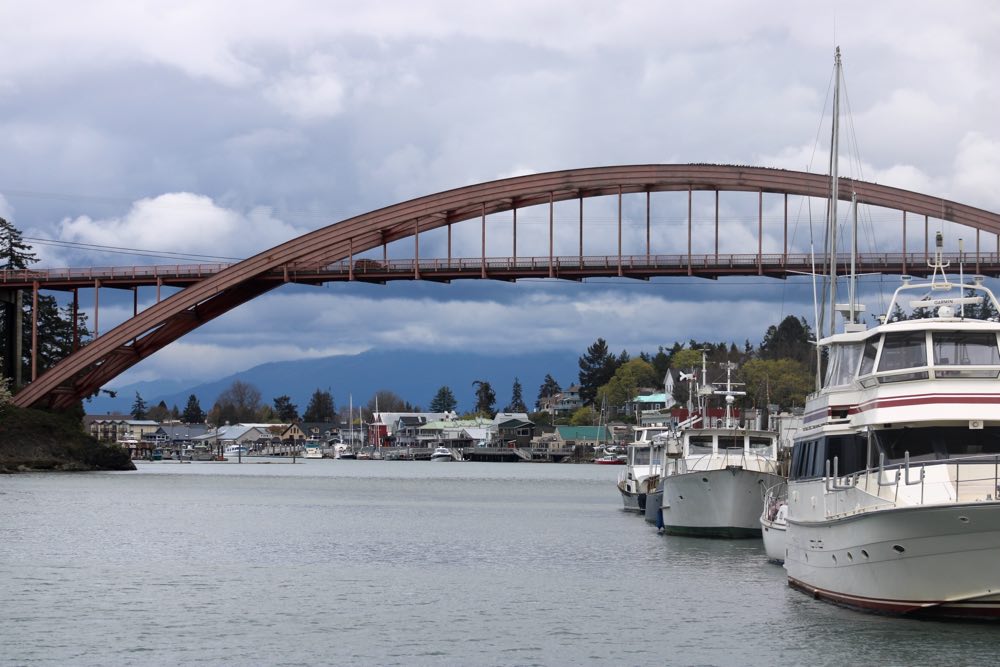
Continuing on into the Swinomish Slough was when we really reached the height of our bird watch for the day. We ticked off another two dozen species, ranging from deluges of various ducks, flighty flocks of red-breasted mergansers, great blue herons standing as stalwart shoreline sentinels and a bevy of bald eagles perched on pilings from La Conner to Anacortes. The day continued with a scenic and moody view of the San Juan Islands on into Roche Harbor.
After a very collaborative effort by the passengers and crew, we ended the day with 38 confirmed species of birds ranging from passerine to alcid. I cannot wait to see what tomorrow holds for wildlife and the connections and experiences we will get to share with our guests.
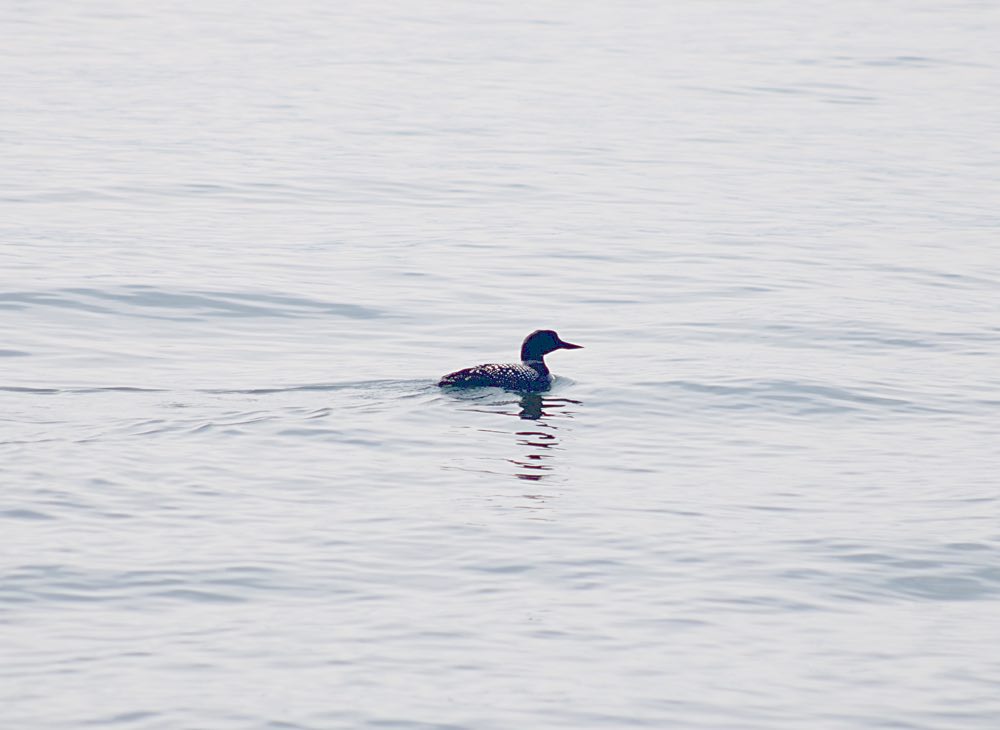
Day 2 – Best Laid Plans
There is a reason we plan so extensively for the 3-day trip. My team and I do our best to calculate everyone’s food, rooming plans and making a dynamic wildlife experience onboard. However, Mother Nature throws a significant variable into our equations.
Today, we dipped out of Roche Harbor knowing we would have some wind to contend with. After a spirited conversation with the passengers about what passerine birds they spotted on their walk to the boat that morning, we had a slight change of plans. Because the dock at Sucia Island was inaccessible due to traffic, tide and wind, we took a chance on a ride to another island state park. We were rewarded with a trip through a place I had never been before, between the “fingers” of the “hand” of the Sucia Island archipelago. The stark, twisty geology of the shoreline yielded about a dozen sea birds with flocks of 40 or so red-breasted mergansers making fast passes over the bow. We spotted a sleepy Canada goose napping under a cave-like overhang in the syncline’s shoreline. It looked cozy despite the rain and wind and we took that as a sign we should make the best out of our situation. We motored over to the north side of the archipelago where a huge gang of Steller’s sea lions were having a discussion about seating arrangements on the rocks. A few juvenile bald eagles soared by, common murres in their winter plumage dove and flapped around the boat and three species of gull’s guided our path back to President’s Channel.

Now was decision time, where do we go from here? It’s the beauty of the 3-day cruise: having the freedom to spend three days going wherever is safe as well as yielding the most variations in wildlife. We thought for sure we would find some nice birds in the more protected Reid Harbor surrounded by Stuart Island: the northwestern most island in the lower 48. It also happens to be a Washington state park with a clear and calm dock to tie up to! On our way in, we spotted a beautiful bufflehead parade, a few horned grebes delicately diving, harlequin ducks tucking in their heads for a nap and the most storybook moment on Gossip Island: a couple of black tailed deer and a Canada goose foraging in the grass and wildflowers! A page right out of a Grace Potter book. If you know, you know.
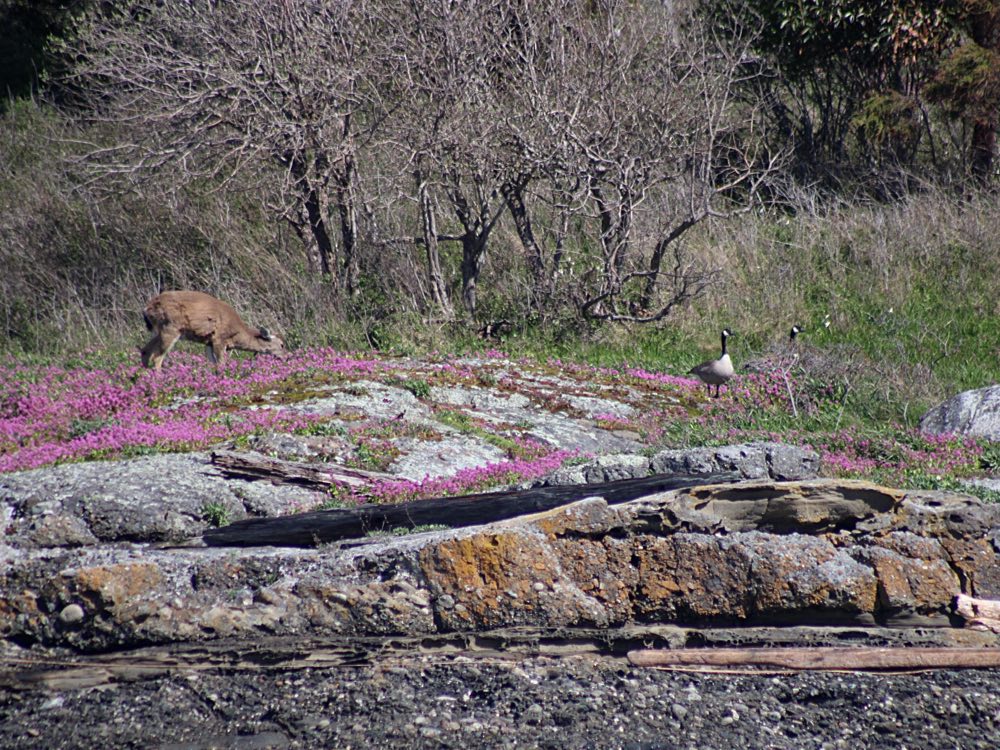
We made it to the dock on Stuart and had a little jaunt around the trails of the park. Some guests went north, others like myself went along the high bluff overlooking where Glacier Spirit was docked. The twisting bark of the hundreds of Madrona trees and tiny, humble wildflowers were a highlight. The flora coupled with sightings of orange-crowned warblers, pine siskins and brown creepers made our birding passengers chirp with cheer in their voice as they returned to the boat and added several more species to our bird checklist.
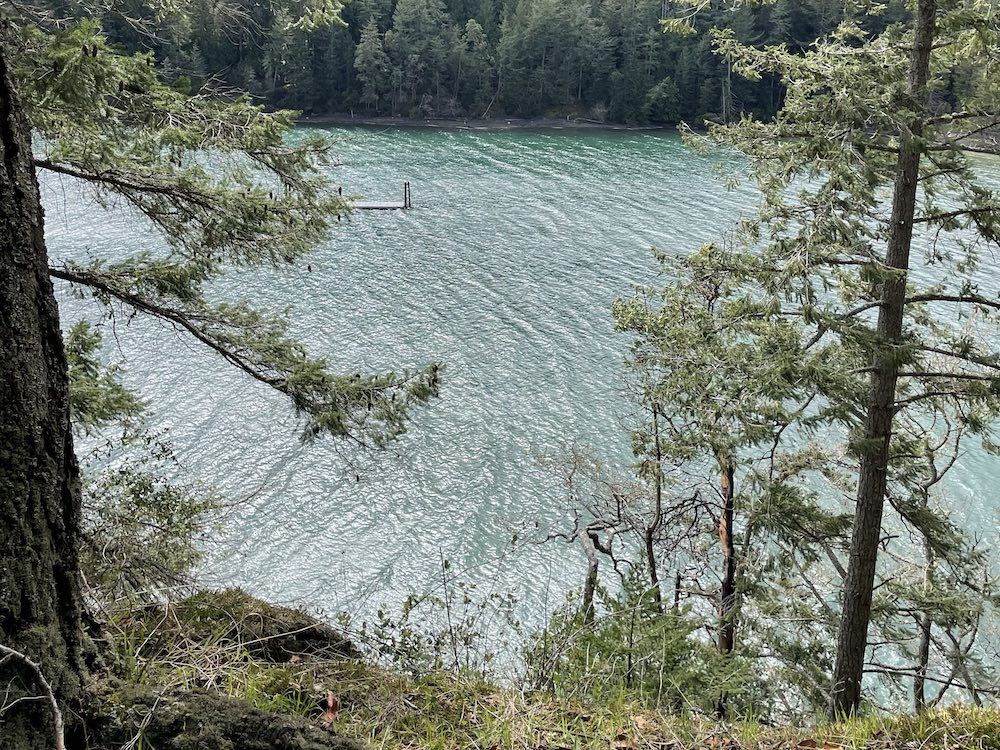
As the sun returned, we headed to Spieden Island, a former game farm where species of deer and sheep were imported in the 70s and 80s. These days, the mouflon sheep and sika deer which are both endemic to Asia, roam the grassy island at their leisure. A herd of sheep stampeded across flushes of purple and pink wildflowers that painted the bright green grass; the plant life was absolutely bursting. Day two ended with 39 species of birds, sea lions, sheep, deer (two species!) and a deep appreciation for my amazing boat crew and passengers who weathered the storm and came out on top.
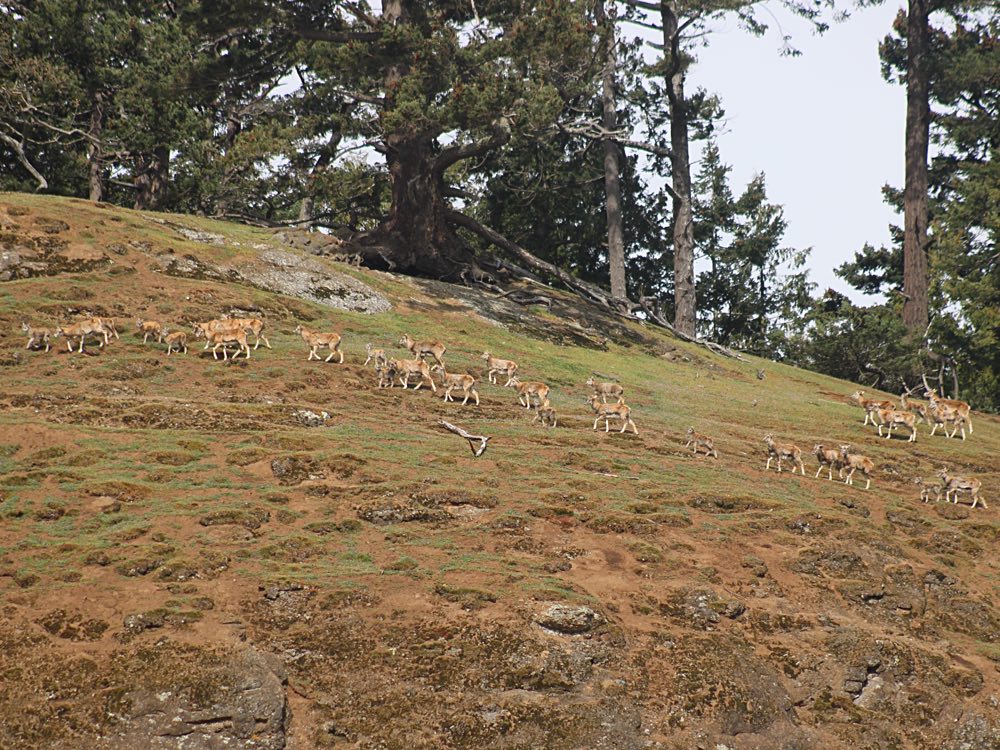
Day 3 – Cruising the Strait
It’s always bittersweet knowing that we will be sending our guests back home or on to the rest of their vacation at the end of the day. As the coffee was poured and the almond croissants crisped up in the oven, our day started with a bald eagle chasing a juvenile gull in an aerial battle all around the docks! The huge eagle with an 8-foot wingspan was also contending with the juvenile’s parents darting in swiftly from behind. If this excitement was any indicator of how our day would go, I was ready for the adventure to begin.
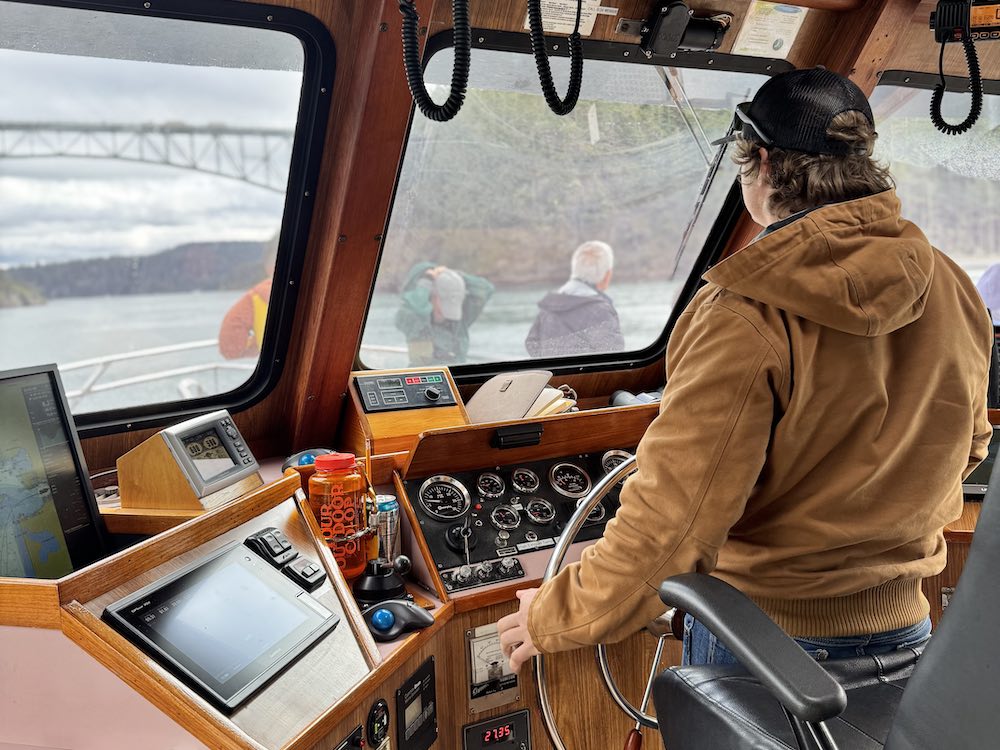
We got off the dock and slowly made our way through Mosquito Pass. We ticked off about 20 bird species before we even reached our cruising speed! This was of course thanks to our avid avian lovers onboard, who had strolled down to the boat with their binoculars and bird checklists in hand. We made it to Haro Strait, the deepest channel in the San Juan Island region and were greeted quickly by sunshine and nice views of the historic Lime Kiln Lighthouse. Decades ago, the now endangered Southern Resident killer whales may have been milling around the lighthouse. These days, we enjoy watching Bigg’s killer whales, whose population is thriving. We didn’t know if any groups had been seen yet today but we all were hoping for more birds and the chance to see an orca in the wild.
Before we would get that chance, we knew we wanted to take advantage of the extremely calm water in the Strait of Juan de Fuca. An underwater mountain called Salmon Bank rests just off the southern tip of San Juan Island. Salmon Bank is a great spot where a phenomenon of upwelling occurs: cold, nutrient dense water is forced to the surface due to tidal currents moving over the varied topography. Those nutrients bring a lot of small schooling fish out to feed and thus their predators which include many sea birds. Once we got to the bank, we floated by a huge flock of at least 200 white-winged scoters. Common murres and rhinoceros auklets dove quickly by, spreading their wings right before they dipped into the feeding frenzy. Gulls of all sorts swirled around to steal a bite from the mouths of the diving birds. A small flotilla of Pacific loons greeted us with close swims near the boat and a few surf scoters with their bright orange bills joined in on the fun.
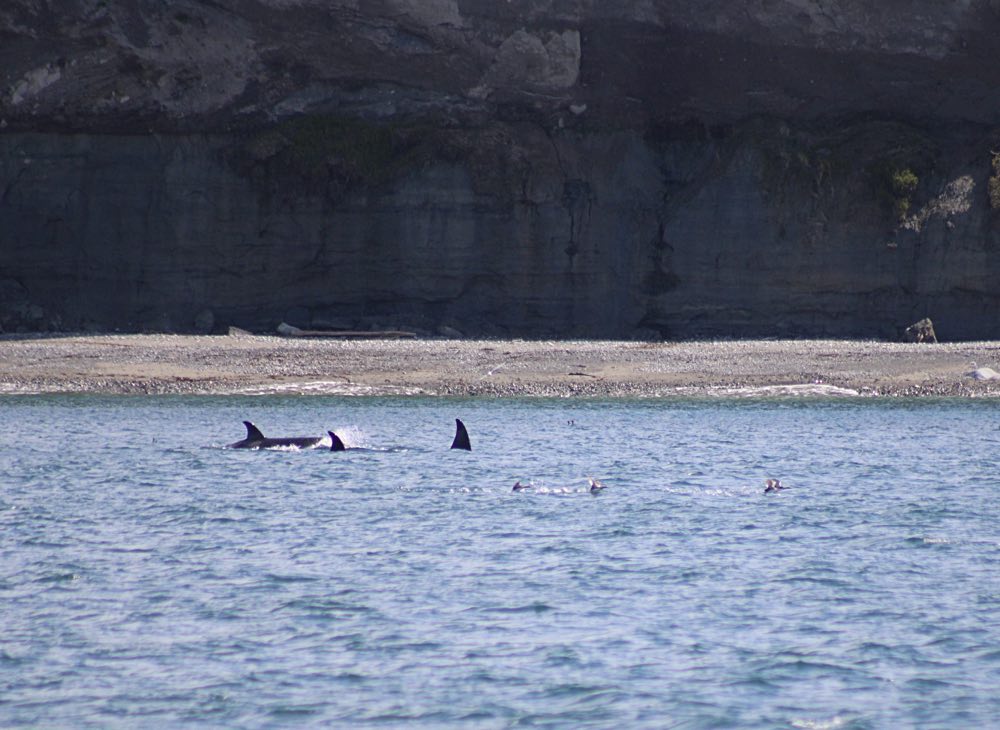
After we had our fill (and so did the birds) we got a call over the radio: one of the other member vessels of the Pacific Whale Watch Association had picked up a family of Bigg’s killer whales! It could not have been more perfect as they were right near our next birding hot spot: Smith Island. We boogied over to the whales and on the way we served my favorite lunch of the cruise – the homemade chowder and tomato bisque! A nice touch of this trip is we have the planning to accommodate food allergies and dietary restrictions and the vegan tomato bisque warmed me up.
With full bellies, we were ready for the whale watch. Much to our happiness, the whales that were found are a famous group of animals: the T46Bs. They are descendants of T46 “Wake” who was actually briefly captured and slated to live in a marine park before activists demanded her and 29 other whales’ release in the 1970s. Now her lineage includes at least 20 known whales related to her including one of the newest additions we got to see today: T46B3A who was first spotted in March 2025. This family now includes “3 under 3” with matriarch T46B wrangling her own 2023 calf (T46B7) along with her second oldest daughter T46B2 who gave birth to a calf that same year (T46B2B). With all the tiny whales in this group (ok tiny is a bit of a stretch considering new born orcas can be 300 pounds) we got to watch the youngsters splash and do headstands waving their teeny tails in the air.
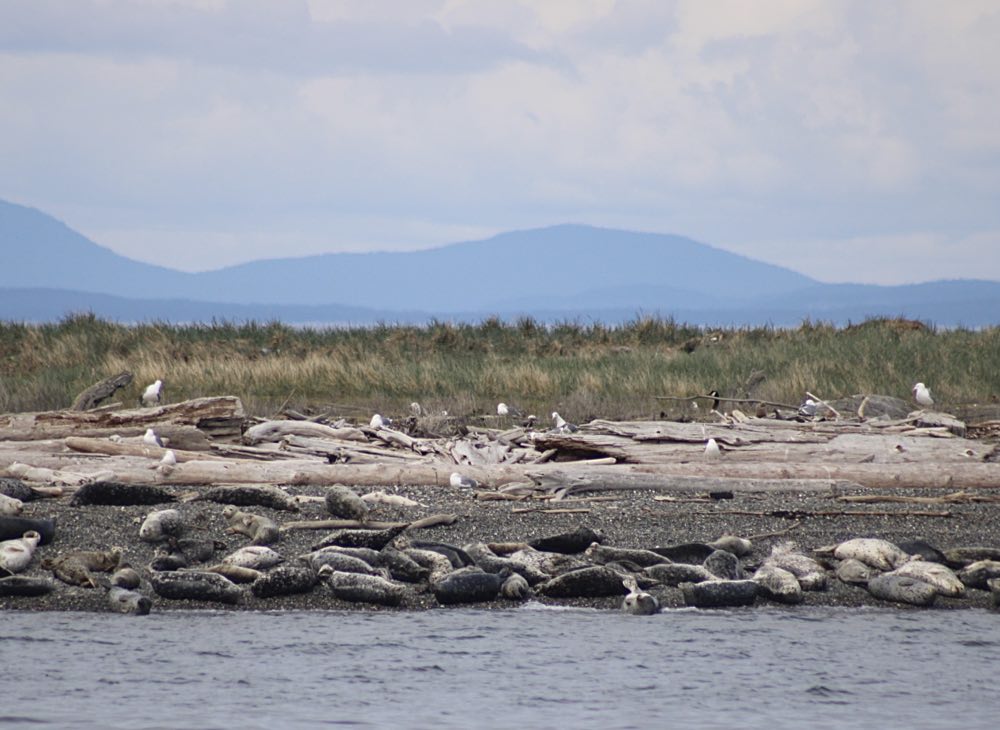
We still wanted to visit the two National Wildlife Refuges nearby, Smith Island and Protection Island, so we said goodbye to the orcas and made our way to Smith. We were a little too early for the birding gem that is found typically in the summer, the tufted puffin. But we still got long-tailed ducks and guillemots galore. After a peaceful pass of Smith, it was time to go to Protection Island. We cruised the plush, green bluffs of the small island which were bursting with plant life after yesterday’s rain. The birds were loving it too with more loons, harlequin ducks, buffleheads, mergansers, gulls, all the alcids and eagles cruising the thermals. We even saw a nice haul out of harbor seals who were basking in the sun on the beach. We joined the seals in their relaxation with a quick cruise back towards Port Townsend while we served ice cream sundaes.
All in all, we saw 47 species of birds on this last day! We parted with our wonderful passengers who I hope had a terrific time; I know it’s a trip I won’t soon forget as I learned a lot, saw many rare and beautiful animals, and made connections with people that will last a lifetime.
Final list of sighted birds:
Accipitrine hawk sp., American Crow, American Robin, Anna’s Hummingbird, Bald Eagle, Belted Kingfisher, Black Oystercatcher, Bonaparte’s Gull, Brandt’s Cormorant, Brant, Brown Creeper, Bufflehead, Canada Goose, Chestnut-backed Chickadee, Common Goldeneye, Common Loon, Common Merganser, Common Murre, Common Raven, Double-crested Cormorant, Gadwall, Glaucous-winged Gull, Golden-crowned Kinglet, Golden-crowned Sparrow, Great Blue Heron, Green-winged Teal, Harlequin Duck, Hooded Merganser, Horned Grebe, House Sparrow, Killdeer, Long-billed Dowitcher, Long-tailed Duck, Mallard, Marbled Murrelet, Northern Flicker, Northern Harrier, Northern Pintail, Orange-crowned Warbler, Osprey, Pacific Loon, Pelagic Cormorant, Pigeon Guillemot, Pine Siskin, Purple Finch, Red Crossbill, Red-breasted Merganser, Red-breasted Nuthatch, Red-necked Grebe, Red-throated Loon, Red-winged Blackbird, Rhinoceros Auklet, Rock Pigeon, Rufous Hummingbird, Short-billed Gull, Song Sparrow, Surf Scoter, Surf/Black Scoter, Tree Swallow, Tree/Violet-green Swallow, Turkey Vulture, Violet-green Swallow, Western Grebe, Western Gull, Western x Glaucous-winged Gull, White-crowned Sparrow, White-throated Sparrow, White-winged Scoter, Yellow-rumped Warbler, godwit sp.

